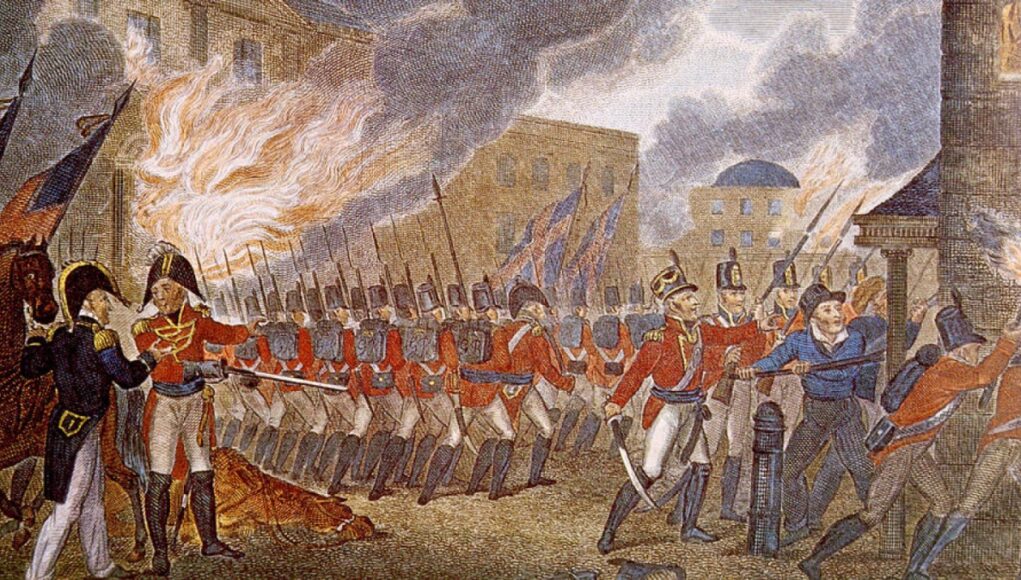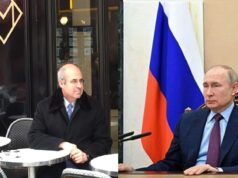This column was first published on the Substack of Jane Hampton Cook. Republished with the author’s permission.
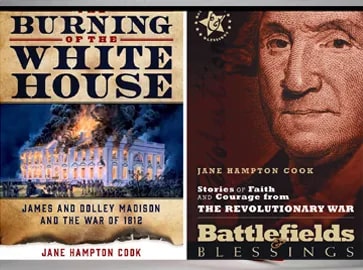
While America’s enemies today are stealth and infiltrated, the first nation-state enemy of the United States was bold and well known. On August 24, 1814, the British Empire struck a major blow against the nation’s capital city, Washington D.C. This excerpt from my book, The Burning of the White House, shows how British soldiers and marines attacked and burned the United States Capitol during the War of 1812.
Once again, British Admiral George Cockburn couldn’t have been happier as the sun began to set on August 24, 1814. He had finally gotten what he wanted: the chance to invade Washington City. If he was lucky, he would capture President and Mrs. Madison, too.
After a rest, the pirate-like Cockburn marched with the dutiful British General Robert Ross from Bladensburg, Maryland, to Washington. The 200 or so soldiers and marines following them were mostly those who hadn’t fought at the Battle of Bladensburg earlier in the day. Among their force were Ross’s soldiers, Cockburn’s Royal marines and sailors, and some slaves who had been forced to serve as British fighters before becoming free. Ever by Cockburn’s side was Lieutenant Scott.
“In the land of liberty, a clear open road led to the capitol, which now rose before us in the twilight,” Scott recalled.
The two-winged U.S. Capitol building welcomed them with an eerie silence. No hustle. No bustle. This castle that usually housed congressmen, not monarchs, seemed as lifeless as a cemetery. Deciding to lead the advance with an offer of parley, Ross ordered a soldier to carry a white flag of truce.
The general hoped to negotiate with the U.S. government over monetary or other capitulation terms. Cockburn had made similar agreements with several Chesapeake communities. If the towns agreed not to fight, then the British soldiers and marines would spare houses and private property. Would Washington City do the same?
They waited for an answer while stopping near a red-bricked mansion at the corner of Constitution Avenue, Maryland Avenue, and Second Street Southeast.
American patriots had an answer for their flag of truce: gunfire.
“And on the general, myself, and some officers advancing a short way past the first houses of the town without being accompanied by the troops, the enemy opened upon us a heavy fire of musketry from the capitol and two other houses,” Cockburn reported of the houses on his right and left.
Sniper fire shot and killed Ross’s horse. Though Cockburn didn’t voyage with Ross across the Atlantic, he knew how important this particular animal was to the general. Everyone knew. This wasn’t just any ordinary horse. Ross had relied on this beast time and time again while fighting Napoleon’s military forces in Europe. Now his most reliable horse was gone.
Also gone was the flag of truce. Replacing it was a determination to silence the snipers. Though the defenders got away, Cockburn sent Scott to search the mansion, which was unoccupied but owned by Robert Sewall of Maryland. The British burned it and another nearby house.
As Cockburn later reported, “. . . these were therefore almost immediately stormed by our people, taken possession of, and set on fire, after which the town submitted without further resistance.”
Ah, Cockburn and Scott later boasted their version of these facts by boosting the numbers. Scott claimed that sniper fire had come from hundreds of Americans hiding in several houses and the Capitol to create a crossfire effect.
“Common sense should have led the authorities to sue for favorable terms for the city, instead of ensconcing a few hundred militiamen behind walls to impede our progress,” Scott reflected.
While the admiral and his officers considered their choice to burn private property as justified casualties of warfare, Americans viewed their actions as barbaric.
“All of this is even more absurd than false. The other houses set on fire were not near Sewall’s house. One of them was General Washington’s house,” Congressman Charles Ingersoll later wrote about a house belonging to the late first president’s estate.
Americans later insisted that the source was a lone gunman positioned at the empty Sewall house, which Albert Gallatin had rented for twelve years before leaving for Europe to negotiate peace with England. The man who fired the shot was thought to be a local drunken barber.
Regardless, Cockburn knew that their decision to burn the properties had the desired effect. No one dared resist them again on their next stop, a tour of the U.S. Capitol.
Meanwhile, U.S. Commodore Thomas Tingey made a decision about the Navy Yard. He was prepared to implement Navy Secretary William Jones’s orders should the fateful hour come.
Jones had earlier given Tingey the responsibility of preparing the Navy Yard to burn it if necessary. If the British marched to Washington, Tingey was to set fire to the stores, provisions, and ships at the Navy Yard to deny the enemy the pleasure of plundering such valuable military items and using them against Americans later. Tingey complied, prepared the yard, and sprinkled a trail of powder throughout.
At half past three o’clock in the afternoon on August 24, Jones learned that the U.S. forces were retreating from Bladensburg. Leaving Tingey in charge at the Navy Yard, he rode over to Mr. Carroll’s house in Georgetown, where he found his family with Dolley Madison. Soon he received word from the president to join him and other cabinet members at Foxhall works, an iron foundry near Georgetown.
Tingey’s problems increased when he received a flurry of objections from residents who lived near the Navy Yard. They rightfully feared that their houses would go up in flames if he set fire to the gunpowder trail.
Though he promised to take “every possible precaution for the safety” of their property and families,” he soon discovered that his words weren’t enough.
“A deputation also of the most respectable women came on the same errand,” he reported. With the pleas of the ladies tugging on his heart, he responded compassionately. “I would delay the execution of the orders, as long as I could feel the least shadow of justification.”
Tingey, however, received a dispatch from War Secretary John Armstrong that “he could protect me no longer.”
Burning the Navy Yard now seemed inevitable. Increasing his worry over collateral damage was the change of the winds, which began blowing South by Southwest around 5 PM. By 8:20 PM he knew he could no longer delay. General Ross was sending a unit of British soldiers to the Navy Yard. He had no choice but to implement Secretary Jones’s order.
“. . . the matches were applied, and in a few moments the whole was in a state of irretrievable conflagration.”
With the Navy Yard ablaze by his own hand, Tingey escaped by boat to nearby Alexandria. Hence, not long after the British arrived in Washington, an American officer set the first fire to U.S. government property.
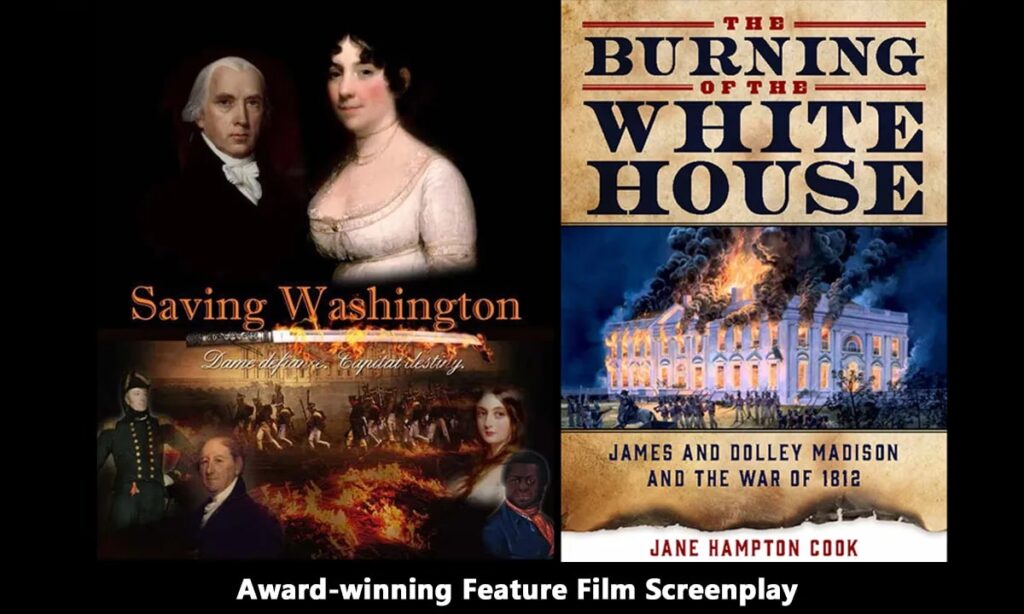
By this time, Dolley Madison had parted the White House. With the business of removing the portrait of George Washington complete, French John and Paul Jennings, a teenage slave, had stayed behind for a while. They contained the fires in the kitchen to avoid accidentally catching the house on fire, which was an irony under the circumstances.
French John shut doors and windows and transported the Madison’s pet parrot, a macaw, blocks away to to the Octagon House, where the French minister to America resided. Because the Octagon housed a diplomat, it was guaranteed immunity from an invading British force and protection for the Madison’s pet.
Departing around twilight to cross the Potomac River, as the British were entering the city, Paul Jennings was the last to leave the White House. Earlier in the day, he had arranged the damask napkins on the State Dining Room table in case President Madison and American soldiers had returned victorious from the battlefield in Bladensburg. He also followed other urgent instructions.
Dolley’s brother-in-law, Mr. Cutts, had “sent me to a stable on 14th street, for his carriage,” as Jennings later recalled.
While he was gone, some vandals entered the White House. “In the meantime, a rabble, taking advantage of the confusion, ran all over the White House, and stole lots of silver and whatever they could lay their hands on.”
Then Jennings left the empty White House.
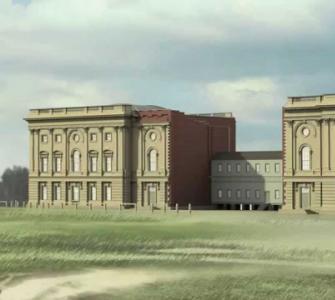
As the British force formed a line facing the U.S. Capitol, they couldn’t help but notice the unusual combination of rustic magnificence. The three-storied Capitol consisted of two independent wings. The Senate wing was on the North; the House, on the South. Connecting them in the middle was a covered wooden walkway. Although they saw this for the first time, these British observers could tell that something was missing. That something was a dome.
“It was an unfinished but beautifully arranged building,” as Lt. Scott described it.
Cockburn couldn’t have been more excited as he and his men entered through the East door of the Capitol’s North wing. Before him was the most symbolic building of America’s representative government. This was where America’s laws were made by leaders elected by the people. This was the place where men had declared war against his country and king. This was to be the first trophy of his glorious attack on Washington City.
With increasing adrenaline, the admiral watched with gleeful mischief as his force fired volleys into the Capitol.
No one fired back, giving them the all-clear sign to storm it.
Then with the awe of tourists, the enemy brigade marched into the magnificent stone vestibule. Inside they found a wonderland of architecture and art. They saw marbled columns carved to look like corn stalks at the top. Italian artists had carved these columns as well as arched entrances, domed foyers, and vaulted ceilings.
If Scott’s recollection mirrored his boss’s, such beauty impressed them both: “The interior accommodations were upon a scale of grandeur and magnificence little suited to pure republican simplicity.”
Why was the U.S. Capitol so regal? Hadn’t the Americans traded royalty for representation?
The British couldn’t believe that the people who so hated kings and castles had built a capitol “infected with an unseemly bias for monarchical splendor.”
Cockburn soon found a treasure trove. On the West side of the Senate wing, one of his men discovered Congress’s library, which was a two-story room with a wooden floor and flat ceiling housing 3,000 books on shelves. Because it was filled with so much paper and wood, it was the most flammable room in the building. The admiral took at least one as a souvenir to prove his unmistakable presence.
The book was titled: An Account of the Receipts and Expenditure of the United States for the Year 1810. After all, he couldn’t very well pose for hours while an artist painted his portrait to capture the moment. The admiral signed the book and intended to give it to his brother, Sir James Cockburn, the governor of Bermuda.
His inscription read: “Taken in the President’s room in the Capitol at the destruction of that building by the British on the capture of Washington, Aug. 24, 1814, by Admiral Cockburn.”
Next to the Senate Chamber, Cockburn’s and Ross’s redcoats found portraits of the King and Queen of France, Louis XVI, and his wife, Marie Antoinette. How perfectly perfect this was. These gems gave them an opportunity to vandalize and perhaps make some money in the process. Because Louis XVI had supported America’s revolution against England, the British military gleefully cut the pictures from the frames and stole them. What price they would bring at another port, no one knew. Yet, they were ideal items for trading or selling.
When the British military entered the House of Representatives Chamber in the South wing, they saw 100 skylights that hung like paneled ribbons along the grand domed-painted ceiling. In addition to seeing Corinthian columns joined by curtain swags along the perimeter, they also viewed handsome desks for each member of Congress arranged in semicircles surrounding the speaker’s chair. Nearby was a beautiful clock.
Hanging above that was a magnificent gilded sculpted eagle whose wingspan stretched twelve feet. Carved by an Italian sculptor, the eagle was one of Benjamin Latrobe’s favorite contributions to his renovation of the Capitol.
Scott also saw the symbolism. The speaker’s chair was “surmounted by a gilt eagle, with extended wings and ruffled crest, looking towards the skies, emblematical, it is to be presumed, of the rising greatness of the young nation.”
With such a site, what was a pirate admiral to do? Why, have some fun, of course. Why not? He had dreamed of this moment for months. Without the poetry of Shakespeare but with the humor of a court jester, Cockburn plopped into the House Speaker’s chair while his men filled the House chamber and sat in the seats belonging to congressmen.
“Shall this harbor of Yankee democracy be burned?” Cockburn called out in his mock trial. “All for it will say aye.”
With the rowdiness of buccaneers drinking ale after capturing another ship, his men cheered and cried out in the affirmative.
Any nays?
No. The vote was unanimous.
Ah. Time for orders. Hence, his men complied. They piled desks, chairs, books, and anything else they could find into mounds in the center of the chamber. Using gun powder, they sprinkled the piles to prepare for an instant conflagration after their fiery rockets struck them.
They evacuated the Capitol. With the last man out, the redcoats started a fire by thrusting their rockets through the windows of the doomed dome-less Capitol.
“Its funeral pile was lighted up as the clock under it told the hour of ten,” according to Scott.
The place became an instant inferno. The worst in man joined forces with the worst in nature to create despicable destruction. Arson. “The position of the Capitol was elevated; the fiery beacon must have shed a sadly brilliant light upon the American habitations for miles around.”
Indeed. The flames were massive, floating high into the sky. From their covered post in an abandoned house in Leesburg thirty miles away, the clerks guarding the Declaration of Independence and other national archival papers grieved in horror as they saw the flames of the Capitol and Navy Yard in the great distance.
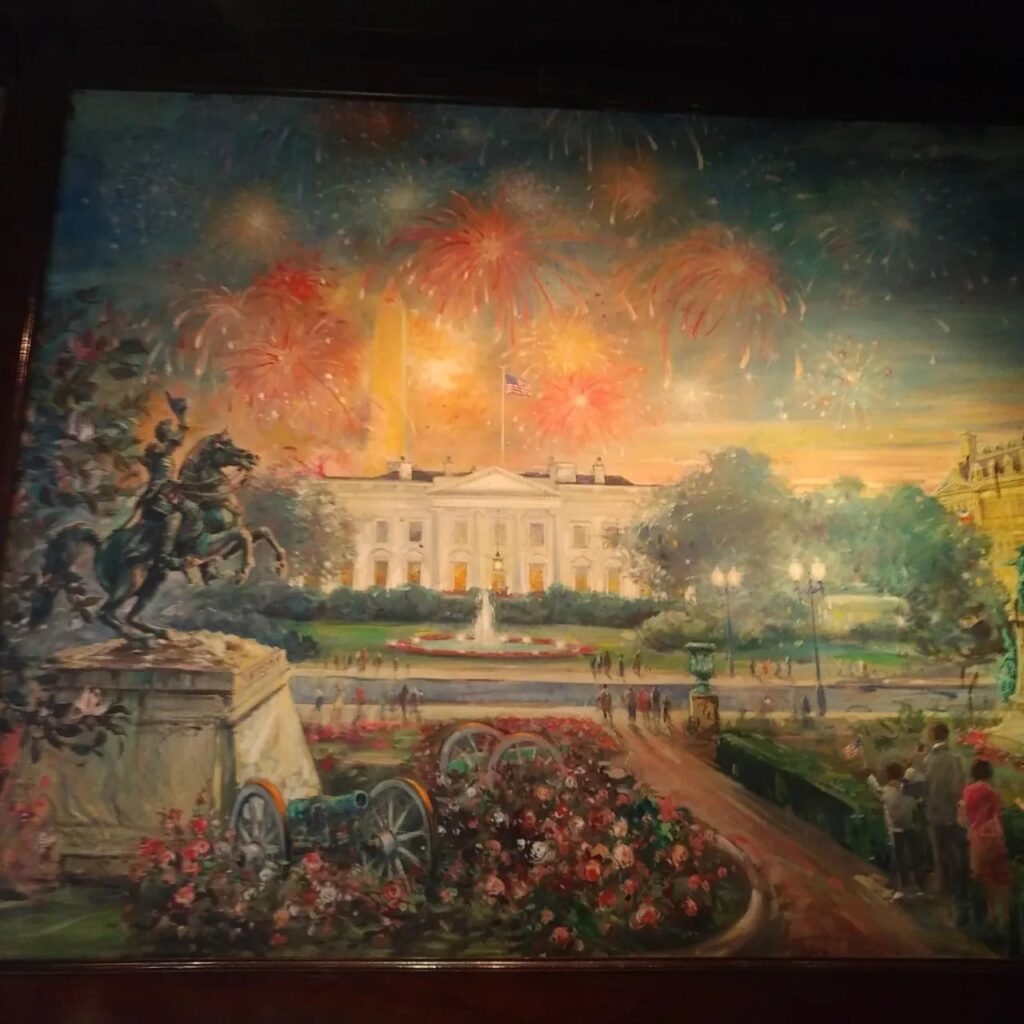
Years earlier George Washington, who had been a land surveyor as a young man, made a critical decision about the location of the President’s House. The city’s first master planner, Pierre L’Enfant, had envisioned a palace about five times larger than the mansion eventually built. L’Enfant had already placed the stakes documenting the perimeter, which was in direct view of the U.S. Capitol, a mile and a quarter away along Pennsylvania Avenue.
Washington disagreed. Tapping his land surveyor skills, he recalculated the stakes of the President’s House to make the house smaller. He also relocated the North entrance, which moved the house out of the direct line of sight with the U.S. Capitol. Thus, Pennsylvania Avenue bended to accommodate the change. As a result, the grand boulevard extended from the Capitol several blocks before making a turn northward at Fifteenth Street.
Mrs. Suter ran a tavern and boardinghouse near this elbow. Though the Capitol didn’t have a direct view of the White House, Mrs. Suter’s property did. Borders at her tavern could enjoy the architectural glory of the White House and the adjacent Treasury Building while enjoying a great meal. Such was her spot’s reputation. Little did she know how far knowledge of her tavern extended.
A few days before the British advanced on Bladensburg, Mrs. Suter had heard a knock on her door. When she opened it, she discovered a British deserter, a straggler begging for food. With her sons called up to the militia, the widow was nervous to allow an English stranger into her tavern. One of her borders, the postmaster general, had advised her against feeding the lad.
Yet, she also had compassion for a youth so abused by the likes of Admiral Cockburn and other British serpents. Could she really turn away someone who was hungry? Didn’t he seem sincere and look a mess? Wasn’t he like her sons and wouldn’t she want someone else to feed them if they were in a similar situation? What was this tavern keeper to do?
She remained true to her job and her business and fed him, though he ate outside.
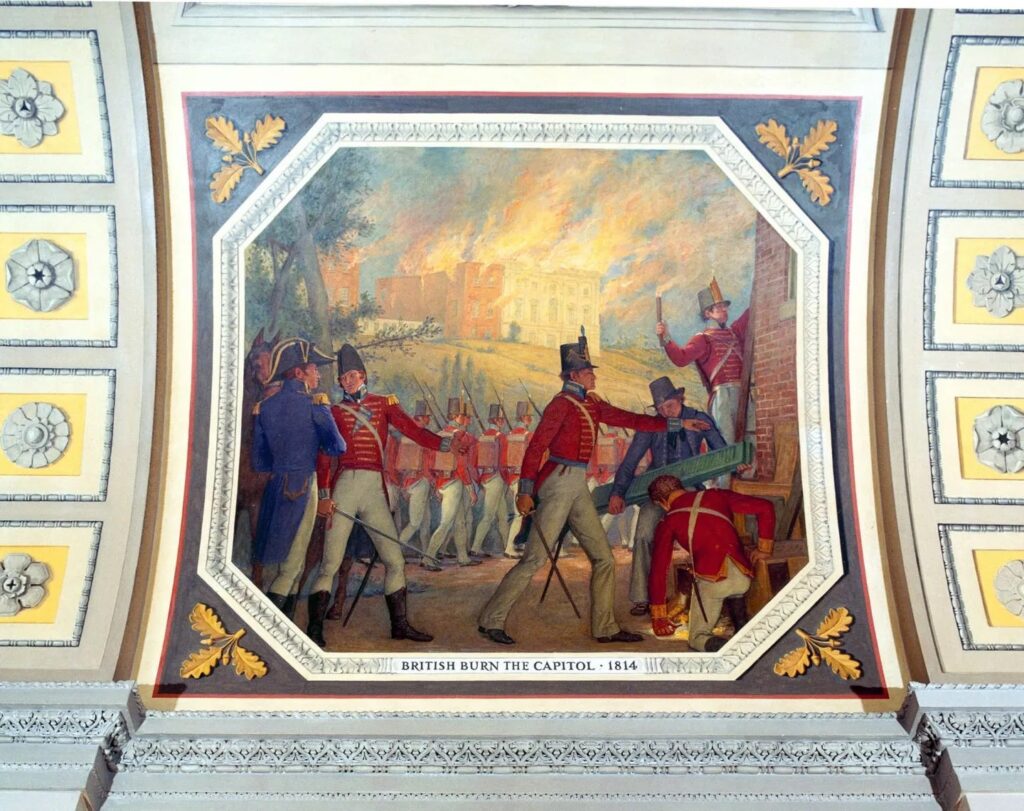
With the Capitol burning behind him, Cockburn mounted his horse. His uniform typically featured erect gold epaulettes glistening on the shoulders of his blue jacket distinguished by a red diagonal sash and gold buttons. With such plumage adorning his fierce instincts, he rode through the streets of Washington City with a combination of a proud peacock, ferocious lion, and a slippery snake.
Cockburn, along with Ross and Scott and a line of redcoats, traveled on horseback down Pennsylvania Avenue, which was a wide boulevard lined with beautiful green trees.
Along the way several British officers stopped by the houses of frightened women and the few remaining men in town. They gave instructions to the residents. Stay inside. Keep quiet. If you do, all will be well.
Following the officers on foot were 100 men who walked in a double file line. The leader of this unit carried a knife and wore a chapeau de bras or a bicorne hat typical of the Napoleonic era.
In the middle of the redcoats’ line were two men who carried lanterns to light their way, though by this point the need for light was hardly great. The Capitol was wrapped in a sheet of flames reaching to the heavens and visible for miles.
The men marched quickly, and mostly quietly, except for a handful of ruffians who began to talk.
“Silence! If any man speaks in the ranks, I’ll put him to death!” their leader called out.
While his men were forced to walk in silence, Cockburn was anything but quiet. When the admiral saw an American man peering out of the window of a house on Pennsylvania Avenue, he decided to have some fun. He and Ross rode up to the house, which provoked a question from the nervous resident.
“Gentlemen, I presume you are officers with the British army?” the American called out. “I hope, Sir, that individuals and private property will be respected.”
Cockburn’s response bore the tone expected of an admiral. He even pulled off his hat and wished him a good evening in a polite and sociable manner.
“Yes, Sir, we pledge our sacred honor, that the citizens and private property shall be respected,” the admiral promised, overlooking the fact that they had burned private houses on Capitol Hill.
Perhaps he detected a doubtful look on the man’s face because he added: “Be under no apprehension. Our advice to you is to remain at home. Do not quit your houses.”
Pleased at the agreement in the man’s eyes, Admiral Cockburn revealed the question most plaguing him as he prepared to capture the White House.

“Where is your President, Mr. Madison?”
The man said he didn’t know and couldn’t tell. But he supposed the president was a considerable distance away by now.
Pity. Tasty cakes would have to wait. Cockburn’s hopes of capturing the Madisons now faded with each clip and clop of his horse down Pennsylvania Avenue. Though having the pleasure of Mrs. Madison’s company now eluded him, what awaited him at the White House was something more dazzling than he ever expected to find.
The Washington Pundit | Speak Truth To Power
Follow Jane Hampton Cook on Substack and Truth Social
Jane Hampton Cook is an award-winning author of ten books, a national media commentator, columnist, a former White House communication staffer, and a presidential historian. Her passion is to inspire patriotism through her writings, historical scholarship and TV appearances.
A contributor to TheHill.com and GenealogyBank.com, Jane is a frequent guest on the Fox News Channel, WMAL, and has appeared on CBN, CNN, BBC, SKY News, CNBC, and other media outlets. She was a historical consultant for the Women’s Suffrage Centennial Commission in 2019-20.
An on-camera storyteller and cast member, Jane has appeared on Brian Kilmeade’s WHAT MADE AMERICA GREAT? on Fox Nation, the George Washington documentary THE FIRST AMERICAN, and the History Channel’s UNITED STUFF OF AMERICA.
Inspired by her 9/11 evacuation from the White House, her feature film screenplay SAVING WASHINGTON placed third out of 1,000 entries in ScreenCraft’s 2018 drama screenwriting contest. SAVING WASHINGTON is adapted from her book, The Burning of the White House: James and Dolley Madison and the War of 1812. Her TV Drama series AMERICAN PHOENIX, about Louisa and John Quincy Adams, was a top ten finalist in ISA’s 2020 Genre Contest in the category of Biography and History.
Jane received a bachelor’s degree from Baylor University, a master’s degree in higher education administration from Texas A&M University, and a research fellowship from the Organization of American Historians and White House Historical Association.
She began her career at Rice University and Texas A&M University before moving to the Texas governor’s office and White House. She lives with her family in a Washington, D.C., suburb.



